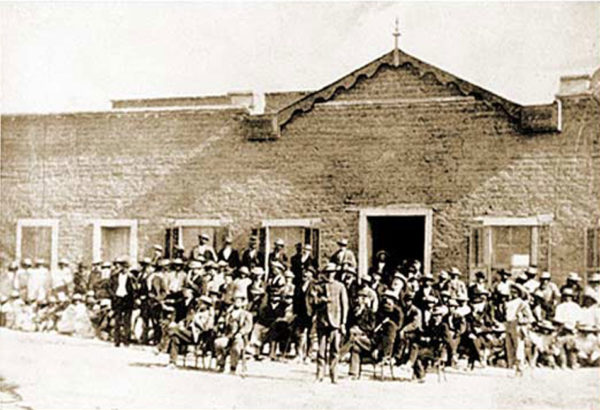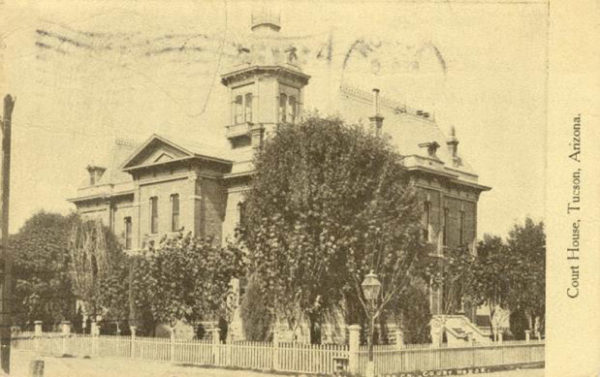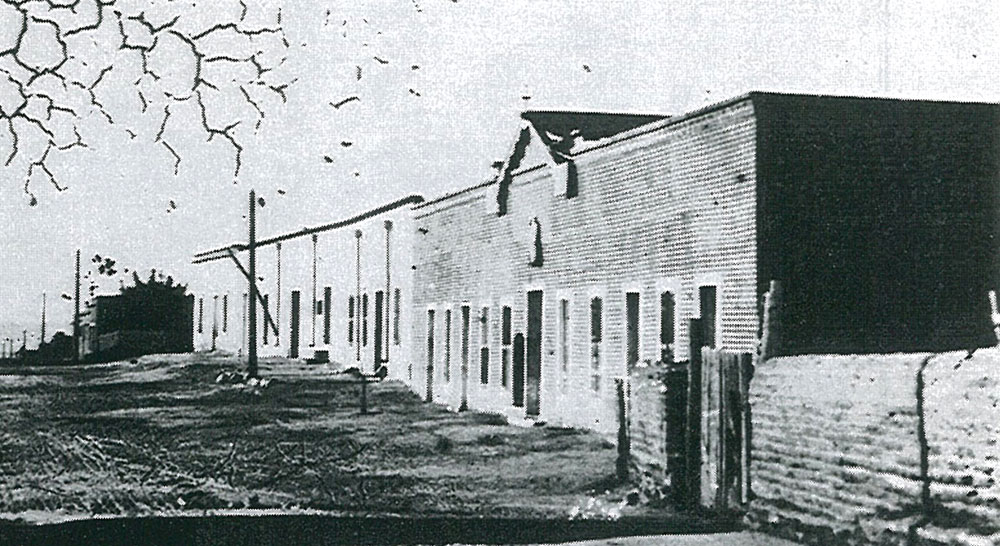
Four Buildings, Six Executions, and a Fountain: The Courthouses of Pima County
Historical archaeologist Homer Thiel presents the history of the four courthouses that have served Pima County. On October 27th, 2018, he will be giving a talk titled “The Five Legal Executions in Pima County” as part of the Presidio San Agustín del Tucson’s Salon & Saloon Lecture Series. During his research for the talk, he actually discovered a sixth execution, and will tell the stories of all six ill-fated men whose sentences were handed down in the courthouses. Details can be found at the end of this post.
On July 17, 1908, Under Sheriff Meyer slid a white hood over the head of Horace Groce. Groce cried out, “My, this is an awful way to die,” moments before he fell to his death, hanged for the murder of his wife Ida Groce. This took place in the courtyard of the 1881 Pima County Courthouse, which was one of four courthouses that have housed Pima County offices. Archaeological research over the past 89 years has provided information about three of these structures, as well as documenting the prior uses of the land these courthouses were built on.
Arizona became a state on February 14, 1863, when President Lincoln separated it from New Mexico Territory. Pima County was one of five original counties, with Tucson as the county seat. Initially, governmental business was conducted in rented spaces. By 1868 a decision was made to build a courthouse. The county purchased Robert Leatherwood’s stables, tore them down, and built an adobe brick structure fronting Court Street, to the west. Decorative wood trim was added a few years later on the front façade. The courthouse is best known for the 1871 Camp Grant Massacre trial, when about 150 men were put on trial for the massacre of over 100 Apache, mostly women and children. A photograph of the defendants lined up in front of the courthouse survives. The men were acquitted by the jury.
The county jail was located on the east side of the courthouse and often saw prisoners escaping by digging through the adobe walls or climbing out, using the backyard outhouse as a ladder. As the population of Pima County grew, the old courthouse was too small to handle all of the work. A new courthouse was constructed in 1881.
The fired-brick building was three stories tall, crowned with a fancy tower. It epitomized the transition from Sonoran architectural traditions and building materials to a modern, Victorian-style behemoth, complete with water-thirsty trees and grass lawns surrounding it. The jail was located at the back of the building. Prisoners housed there were charged with crimes including murder, manslaughter, assault, rape, burglary, forgery, bigamy, and “crimes against nature.” A storage space held the gallows, hauled out six times between 1881 and 1908.
In 1928, the courthouse began to suffer from structural problems, with walls cracking and the second floor threatening to collapse. It was decided to tear it down and construct a new building. As work was being undertaken, former City Building Inspector Donald Page uncovered adobe bricks from the walls of the Spanish and Mexican-era Presidio, the fort that once protected Tucson between 1783 and 1856. He salvaged some of the bricks, which were used in a display on the south side of the new courthouse.
The Spanish Colonial style building had an addition built along the south side. Two Hollywood movies have been filmed there, the 1956 “A Kiss Before Dying,” starring Robert Wagner and Joanne Woodward, and the 1976 movie “A Star is Born,” starring Barbra Streisand and Kris Kristofferson. It was listed on the National Register of Historic Places in 1978. The building was vacated in 2015 when the new Pima County Consolidated Justice Court building opened.
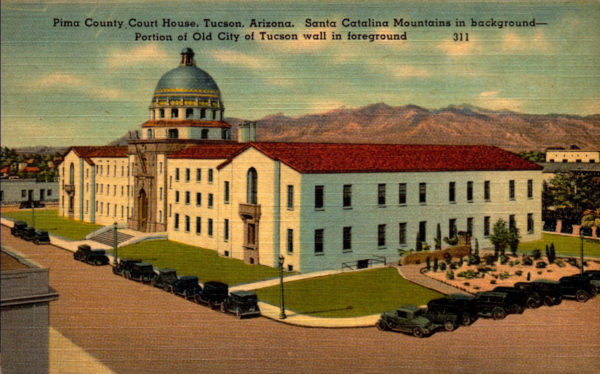
A postcard of the 1929 Pima County Courthouse. Visible on the right side is a reconstructed portion of the southeast corner of the Presidio Wall. This was removed in 1955 when an addition was added on this side.
In 1992, the Center for Desert Archaeology (today Archaeology Southwest) conducted test excavations in the courtyard of the 1929 Pima County Courthouse. We were looking for the Presidio fortress east wall, which we eventually located. We also found the floor joist piers for the 1881 jail and the floors of the City Marshall’s office, which was once part of the 1868 Courthouse.
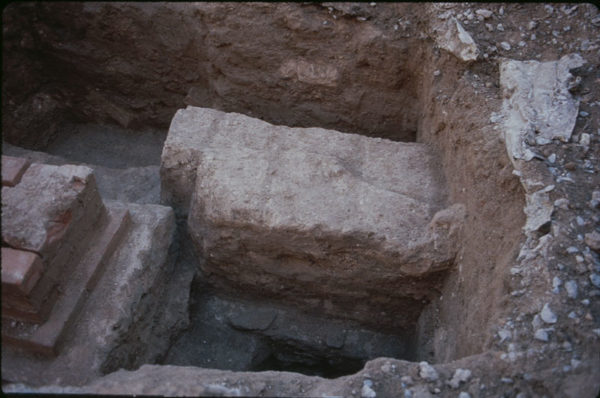
A fired-brick floor support pier from the 1881 Courthouse (left), along with a section of the east adobe wall of the Presidio San Agustin del Tucson (center).
In addition, we found the foundations of a hexagonal fountain that was built for the 1929 courthouse, but was dismantled after the foundations settled onto one of the 1881 jail floor joist piers, cracking the fountain. It was the Depression era, and there was no money to repair it, so it was torn down. Scattered around it were fragments of the decorative tile that had adorned it. After the excavation, the fountain was recreated, but using tile patterns depicted on the original plans—designs that did not match the pieces found. A photograph later revealed that the archaeological tiles had in fact once adorned the fountain.

A postcard of the 1929 Pima County Courthouse showing the interior courtyard. The fountain depicted was torn down and was later rebuilt in 1993.
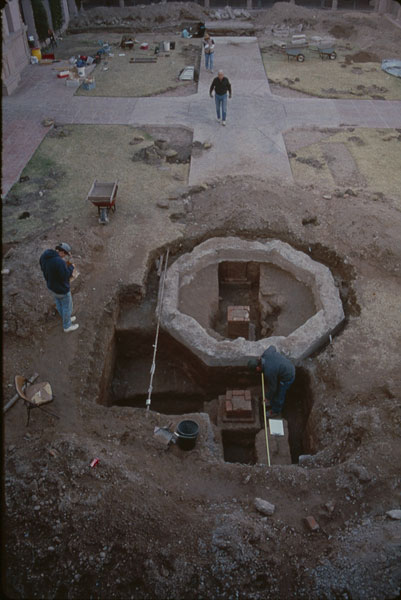
The 1929 Courthouse fountain, located during a dig conducted in 1992. The section of the Presidio wall shown above is visible here with a clipboard on it, next to the man with the measuring tape, in the lower right portion of the excavation pit (photo by Homer Thiel).
By the early 2000s it was decided that the 1929 Courthouse was too small to handle the functions of a county with more than a million people. A new location was selected a few blocks to the northeast for the Pima County Consolidated Justice Court. Statistical Research, Inc. subsequently conducted archaeological excavations of the large site, finding a pair of Early Agricultural period pit structures, over 1,000 burials from the National Cemetery (also called the Alameda-Stone Cemetery), Territorial-era house foundations, privy pits, and wells, and the remnants of Statehood period businesses.
The 1929 Pima County Courthouse is currently being renovated for a new uses. In early 2019, an archaeological excavation will take place on the west side of the building. A reflecting pool is being constructed for the January 8th Memorial, commemorating the 2011 mass shooting in Tucson in which six people were killed and thirteen others injured. Desert Archaeology has been monitoring trenches for new utilities and has discovered the stone foundations of two buildings that may be depicted on the 1862 map of Tucson. We also found a burned Hohokam pit structure. We expect our work will provide new information about the prehistoric and historic era uses of the area.
Resources
Salon and Saloon Lecture Series, A Halloween Lecture: Five Legal Executions in Pima County, by Homer Thiel. Saturday, October 27, 2:00 pm, the Dusty Monk Pub, $5 at the door. The Dusty Monk is located in the southeast corner of the La Cocina/Old Town Artisans compound, 201 N. Court Avenue, Tucson.
For more courthouse-related fun facts, visit the Evo A. DeConcini United States Courthouse’s exhibit detailing the history of federal courthouses in southern Arizona. Desert Archaeology contributed interpretive signage accompanying a display of courthouse-related artifacts, including a stuffed bald eagle and Prohibition-era liquor bottles. The display is free and open to the public, and can be visited on the second floor of the building at 405 West Congress Street in downtown Tucson during regular weekday business hours.


